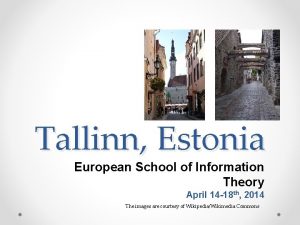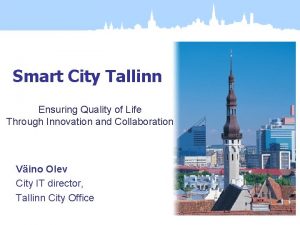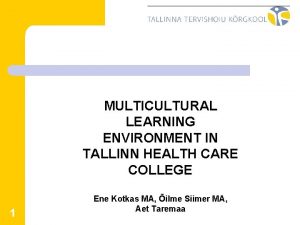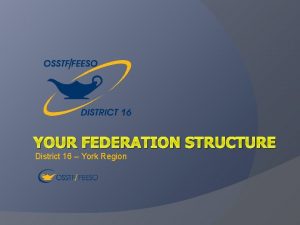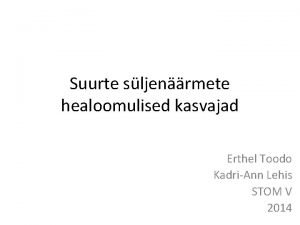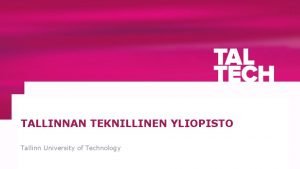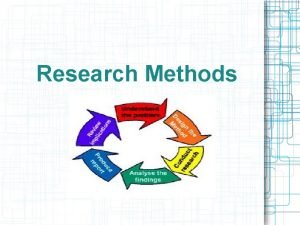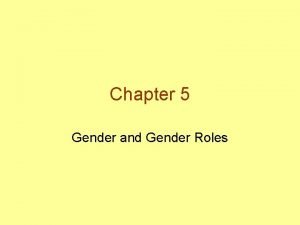GENDER IN RESEARCH METHODS KADRI AAVIK TALLINN UNIVERSITY







































- Slides: 39

GENDER IN RESEARCH: METHODS KADRI AAVIK, TALLINN UNIVERSITY August 25, COST workshop, Tartu

ABOUT ME Ph. D candidate and lecturer in sociology at Tallinn University Ph. D thesis: “Intersectional Disadvantage and Privilege in the Estonian Labour Market: An Analysis of Work Narratives of Russian-Speaking Women and Estonian Men” (2015) Research areas and interests: sociology of gender, feminist research, intersectionality, critical studies of men and masculinities, gender and work, qualitative methods, narrative inquiry, feminist and intersectional methodologies, microsociology, critical animal studies Active in the Estonian civil society since 2007: gender equality, social equality more broadly, animal rights

STRUCTURE OF THIS SESSION Overview of some useful concepts and distinctions Feminist critique of “malestream” epistemologies and research practice Feminist epistemology and methodology, feminist research practice Gender on different analytical levels Broad focus points and areas of inquiry in contemporary feminist research - intersectionality New directions in feminist research Questions and discussion

GENDER RESEARCH = FEMINIST RESEARCH? Would you make a distinction? What kind? Not necessarily equivalent. For instance, research aiming to document differences between men and women in some area of life might help to reproduce the gender division and the category of gender Feminist sociology tends to be explicit about its epistemological positions and values, agenda of social change A question of aims of the research and the kinds of questions asked, epistemological and methodological approaches How is gender understood? Social constructionism vs essentialism

ONTOLOGY, EPISTEMOLOGY AND METHODOLOGY, METHOD Ontology: what is reality and how do we understand being? Epistemology: what is knowledge and how can we know? Methodology: research design and strategy stemming from ontological and epistemological positions Method: specific techniques or procedures used in research

FEMINIST EPISTEMOLOGY Since 1970 s How does the category of gender inform our understanding of knowledge, knowers and the process of gaining knowledge? The aim is to rethink and change dominant epistemological and methodological positions in a discipline

FEMINIST CRITIQUE OF TRADITIONAL RESEARCH PRACTICE Gender binary - emphasising gender differences, (re)producing the binary gender system Failing to take into account structural and institutional conditions that contribute to systemic privilege of some groups over others Andocentricism – conducting research from an implicit male perspective, women are rendered passive and their agency denied Implicit biases – researchers’ tacit assumptions on what is appropriate and “natural” for men and women Essentialising the category of gender Drawing a clear distinction between research and politics Generalisations – research results using male subjects are generalised to apply also to women (for instance, in medical research) Values and interests distort and limit the production of knowledge: for example, sexist, racist, heterosexist and Anglo. American-centered values have led to the construction of knowledge from certain perspectives. Gaps in knowledge

FEMINIST CRITIQUE OF CLASSICAL SOCIAL THEORY (MARSHALL & WITZ 2004) Ignoring the contribution of women (both as subjects of research and authors of sociological texts), selecting and legitimising only certain perspectives and values Social construction of the sociological “canon of classics”, sociology as a colonial project (Connell 1997) Positivism, objectivity, neutral values Masculinity as a central category defining the social The centrality and privilege of the male subject in sociological theory Classical sociological texts marked women as gendered beings, whereas men appeared as non-gendered humans, generic people

CONTINUED. . Classical sociology constructed gender differences, located these in biology Women associated with bodies, men with minds Women in the texts of classical sociology: strategic absence Men in texts of classical sociology: absent presence (always present, but not gendered) Masculine ontology: implicit gender difference, masculine values

CONTINUED… How does implicit masculinity shape the understanding of the social? Durkheim and Simmel: modernity was based on gender distinctions, women did not experience modernity, were not granted the status of modern subjects In defining modernity, boundaries between the private and the public became crucial, with the latter established as the centre of sociological focus Women thus did not experience the institutional dimensions of modernity, which were tacitly gendered (seemingly genderneutral concepts such as worker, citizen, consumer etc. entered sociological theory) Dualisms: private/public, universal/particular were created

FEMINIST RESEARCH PRACTICE (1) Placing gender at the centre of inquiry Value free research is impossible and unnecesssary Socially engaged research, which is ethically and politically responsible Starting point: the situation and opportunities of women (and other marginalised groups) are worse than those of men (and other privileged groups) in most areas of social life Women’s lives and experiences have been considered less worthy Aims: identifying the structures and conditions that uphold a social order that privileges men Raise awareness of the existence and functioning of these structures Offer solutions to mitigate the problem Empowering and giving voice to marginalised groups Advancing non-exploitative research practice Knowledge production must be useful to women and other marginalised groups Aiming for social change (Sarantakos 2005: 55)

FEMINIST RESEARCH PRACTICE (2) No specific “feminist methods” – various methods can be used, epistemological and methodological questions are relevant Using traditional methods to approach new topics, using research results to empower marginalised groups and advance social equality Aiming to minimise power relations between researcher and research participants Research aims to be inclusive, collaborative, empowering marginalised groups and useful to them, challenging hierarchies Self-reflexivity of researchers (positioning in relation to research participants) Does not necessarily imply qualitative methodology. Quantitative approaches are useful in documenting largescale gender inequalities (i. e. gender pay gap)

“Feminists (and others) have argued that being objective and value-free is not only impossible, since we all carry experiences and values that shape our vision and interpretation […]Indeed, Pat Caplan (1988) suggests that objectivity is simply a form of male subjectivity. ” (Wolf 1996: 4)

STANDPOINT-EPISTEMOLOGY (HARDING, SMITH) The material and lived experience of an individual structures his/her understanding of his/her social environment Example: The perspective of a worker is more comprehensive than that of a capitalist. In order to survive, the worker must understand his/her own world, as well as the capitalist’s. Placing marginalised perspectives at the centre of knowledge production Situated knowledge: knowledge is inseparable from experience, knowledge is always produced in a specific time and space, contextualised knowledge

CONTINUED. . “There are important things to learn from taking seriously the perspectives of all marginalized groups—not just of various groups of women, but men and women in postcolonial societies, men and women of color, gay men, and so forth. A system of knowledge that draws on their insights and starts from their predicaments will be richer than one that draws only on the insights and starts from the predicaments of privileged groups alone” (Harding 1993).

FEMINIST SOCIOLOGY An academic and political approach to studying the society Feminist sociology (Smith 1989) – reformulation of social theory in such a way that it would systematically take into account ways in which the category of gender impacts the perception of reality; recognition that gender is a basic dimension of social life, a central category of analysis in sociology, without which it is not possible to understand central areas of research in sociology and social institutions (work, education, religion etc. ) Reading classical social theory from the gender perspective (Marshall & Witz 2004; Connell 1997)

LEVELS OF RESEARCH/ANALYTICAL FOCUS Gender operates on different levels of social life: individual, group, institutional or micro, meso, macro Individual level – binary gender system, all individuals are classified into men or women Gender in social interactions Gender in institutions These levels of analysis complement each other

STUDYING GENDER ON THE INDIVIDUAL LEVEL Psychological approaches: focus on individuals, gender is seen as an innate, fixed and stable characteristic Social constructionist approaches: gender as socially constructed, manifested in individual accounts

INTERACTONIST APPROACHES Focus on individuals in social interaction, context in which they interact, microsiociology Meaning is produced in these interactions “Doing gender” (West & Zimmerman 1987) gender is not a stable category, not a characteristic, but created in everday social interactions, so that it appears “natural” “doing difference” (West & Fenstermaker 1995) other social categories also produced in interaction Critique, problems: emphasis on the fluidity of gender, not good at explaining social interactions which challenge gender difference

INSTITUTIONAL PERSPECTIVE: GENDERED INSTITUTIONS AND ORGANISATIONS (WHARTON 2012) Interactions take place in institutions and organisations Emphasis on those aspects of social life that are organised, regular, seem permanent and often remain unchallenged Structures, patterns, routines and meaning systems of institutions Gendered institution – gender is part of the processes, practices, ideologies and power relations in the organisation (Acker 1990) Institutions shape people’s beliefs and values about the social world, including about gender. These in turn shape institutions Focus on social structure Gender is not a property of individuals, but an aspect of social organisation Critique, problems: how does gender become part of social organisation, how do gender norms and gendered practices come into being and get (re)produced?

BROAD FOCUS POINTS AND AREAS OF INQUIRY IN CONTEMPORARY FEMINIST RESEARCH Not simply adding new knowledge, but transforming existing knowledge by taking into account gender Gender analysis of institutions and practices traditionally considered gender neutral (work, law, organisations etc. ) International comparative research Critical studies of men and masculinities “Studying up”

CRITICAL STUDIES ON MEN AND MASCULINITIES Interdisciplinary field, part of gender studies Focus on men as gendered beings, “naming men as men” (Hearn 2004) Focus on historical and cultural constructions of masculinity, male privilege Critique of men’s rights movements Gender as relational Masculinities and their hierarchy, hegemonic masculinity (Connell 1987)

BROAD FOCUS POINTS AND AREAS OF INQUIRY IN CONTEMPORARY FEMINIST RESEARCH (CONTINUED) Differences within the categories of woman and man, femininities and masculinities Gender and its interaction with other social categories and divisions (intersectionality)

INTERSECTIONALITY Gender is not the only or primary category through which social inequalities are sustained and reproduced Other categories of identity and difference are also important: age, sexual orientation, ethnicity/race, class etc. These categories intersect in different social contexts and these intersections help to produce experiences of marginalisation or privilege All identities are intersectional, also privileged ones Gender acquires its meaning in interaction with other categories Categories cannot be separated in people’s identities and experiences, they are fused into one experience for people Example: ways in which black women experience racism is affected by sexism they experience and vice versa

"People experience race, class, gender and sexuality differently depending upon their social location in the structures of race, class, gender and sexuality. For example, people of the same race will experience race differently depending upon their location in the class structure as working class, professional managerial class or unemployed; in the gender structure as female or male; and in structures of sexuality as heterosexual, homosexual or bisexual” (Veenstra 2011)

CONTINUED. . Intersectionality works on different levels: not enough to focus only on individual identities, but also important to look at ways in which institutional systems produce and represent these categories Social categories differ ontologically (methodological implications): - visibility (sexuality vs gender and race) - choice (religion) - change/durability (gender vs age) Michael Kimmel „On Gender“

INTERSECTIONAL METHODOLOGIES Assumptions: - people’s experiences are structured by being positioned differently in terms of different social categories and their intersections - categories should be visible in people’s accounts of their lives and experiences Challenges and questions: - which categories are relevant in a given account? - how to understand the relationship between them? - what to do with accounts lacking explicit references to social categories?

NEW DIRECTIONS IN FEMINIST RESEARCH “Undoing gender” (Deutch) New materialism (Fausto-Sterling, Grosz, Barad) Posthumanism (Haraway etc. )

UNDOING GENDER (DEUTSCH 2007) Starting point - the concept of “doing gender“ (West & Zimermann 1987): gender produced in everyday interaction, dynamic, not fixed Critique: universality of doing gender, no exit from the existing gender system, few possibilities for change. People participate in doing gender even if they challenge existing gender norms. Creating difference instead of reducing it. Gender takes precedence over other categories, eclipsing other statuses and roles

CONTINUED… “How can we undo gender”? Under what conditions and how do social interactions become less gendered? (men and women increasingly working in similar areas, change in attitudes over time) In which social interactions does gender not play a role? (situations where other categories can be more important) Do all social interactions entail/ lead to gender inequality? Difference = inequality? How do the structural and interactional levels interact to contribute to change? (quota system, fathers’ parental leave can contribute to the emergence of more egalitarian attitudes) Interaction as a locus of change – need to study interactions which challenge prevalent gender constructions Undoing gender – social interactions which diminish gender difference

NEW MATERIALISM An area of social science, which critiques antropocentric thinking and rethinks subjectivity How does human activity interact with objects and matter (inanimate objects)? Influences from physics, biology, philosophy etc. Starting point: the existence of the material body has been problematic for feminists (historical association of women and other marginalised groups with the body, biological essentialism), hence focus has been on the social construction of gender The existence or impact of matter to the social should not be ignored, including in knowledge production Traditional feminist research is interested in the ways in which “bodies are inscribed by culture” (Frost 2011: 70): this assumes that we understand what these bodies are and how they are opened up to cultural inscription “Feminists have been more comfortable with ‘denaturalizing nature’ than ‘deculturalizing culture’ or admitting that biology might have a form of agency or force that shapes, enhances, conditions, or delimits the agency of culture” (Frost 2011: 76)

CONTINUED… “In turning to culture to evade the determinism implicitly associated with the biological body, feminists recapitulate the modern fantasy of freedom, autonomy, and selfdetermination that they have otherwise so carefully dismantled” (Frost 2011: 76) Culture and biology are mutually constitutive, this interaction should be explored “Nature is open to any kind of culture, to any ‘artificiality’, for culture itself does not find pre-given biological resources, but makes them for its own needs, as does nature itself” (Grosz 2004, 72) Exploring “how the forces of matter and the processes of organic life contribute to the play of power or provide elements or modes of resistance to it” (Frost 2011: 70)

GENDER AND POSTHUMANISM Posthumanism: critique of traditional humanism, decentering the human, human life is one out of many. Challenging the ideals of disembodiment, and autonomy (Wolfe 2010) - human-animal studies, critical animal studies Donna Haraway “A Cyborg Manifesto” (1991): shifting boundaries between humans, animals and technology

THE BROADER CONTEXT WE AS RESERACHERS ARE SITUATED IN Neoliberalisation and corporatisation of universities, the implications of this for our research agendas (critical university studies) Self-reflexivity about our academic lives and everyday practices How are gender researchers (mostly women) positioned in the academy? What obstacles do they face in their career tracks? In what ways is the occupation of a scientist gendered, so that it tends to fit better to male life paths and career tracks? Etc.

PROJECT “SUPPORTING THE CAREER TRACKS OF FEMALE RESEARCHERS” Aims: supporting the career tracks of young female academics Activities: mapping the current situation in Estonian universities, overview of practices other countries, developing measures to support female academics Partners: Tallinn University, Tartu University, Tallinn University of Technology, Estonian Business School Donor: Estonian Ministry of Social Affairs, Norway Grants www. tlu. ee/eneke

QUESTIONS FOR DISCUSSION How do you understand use the category of “gender” in your research? What epistemological/methodological/ethical dilemmas have you encountered when using gender as an analytical category in your research?

LITERATURE Acker, J. (1990). Hierarchies, jobs, bodies: A theory of gendered organizations. Gender & Society, 4, 139 -158 Connell, R. (1987). Gender and power. Sydney: Allen and Unwin Connell, R. (1997). Why is Classical Theory Classical? The American Journal of Sociology, 102 (6), 1511 -1557 Deutch, F. (2007). Undoing Gender and Society 21: 106, 106127 Fenstermaker, S. , West, C. (2002) (Eds) Doing Gender, Doing Difference: Inequality, Power and Institutional Change. New York: Routledge Frost, S. (2011). The Implications of the New Materialisms for Feminist Epistemology. In Grasswick, H. E. (Ed. ), Feminist Epistemology and Philosophy of Science: Power of Knowledge. New York: Springer, 69 -83 Grosz, E. (2004). The nick of time: Politics, evolution, and the untimely. Durham: Duke University Press

LITERATURE Haraway, D. (1991), ‘A cyborg manifesto: science, technology, and socialist-feminism in the late twentieth century’, in D. Haraway, (ed. ), Simians, Cyborgs and Women: The Reinvention of Nature, New York: Routledge. 149– 181 Harding, S. (1993). Rethinking standpoint epistemology: What is “strong objectivity”? In L. Alcoff & E. Potter (Eds. ), Feminist epistemologies. New York: Routledge, 49 -82 Hearn, J. (2004). From hegemonic masculinity to the hegemony of men. Feminist Theory, 5(1), 49 -72 Marshall, A. , Witz, A. (2004). “Introduction: feminist encounters with sociological theory” In: Marshall, B. , Witz, A. (Eds. ). Engendering the social. Feminist encounters with sociological theory. Open University Press, 1 -11

LITERATURE Sarantakos, S. (2005). “Feminist Research”. In: S. Sarantakos (Ed. ). Social Research. New York: Palgrave Mc. Millan, 53 -71 Smith, D. (1987). The Everyday World as Problematic: A Feminist Sociology. Northeastern University Press Veenstra, G. (2011). Race, gender, class, and sexual orientation: intersecting axes of inequality and self-rated health in Canada. International Journal of Equity Health, 10(3) West, C. , Zimmerman, D. (1987). Doing Gender and Society 1(2): 125– 51 Wolfe, C. (2010). What is posthumanism? Minneapolis: University of Minnesota Press
 Taltech library book a room
Taltech library book a room Taltech ico maja
Taltech ico maja Strategic gender needs and practical gender needs
Strategic gender needs and practical gender needs Gerttu aavik
Gerttu aavik Demograafiline kriis
Demograafiline kriis Kalev aavik
Kalev aavik Gerttu aavik
Gerttu aavik Gerttu aavik
Gerttu aavik Research methods notes kenya
Research methods notes kenya Tallinn school of economics
Tallinn school of economics Tallinn european school
Tallinn european school Sunfix tallinn
Sunfix tallinn Tallinn
Tallinn Tallin population
Tallin population Tallinn health care college
Tallinn health care college English speaking family doctor tallinn
English speaking family doctor tallinn Värskeõhuklapi paigaldus
Värskeõhuklapi paigaldus Tallinn smart city
Tallinn smart city Uhiskaart tallinn
Uhiskaart tallinn Nadezda fjodorova tallinn
Nadezda fjodorova tallinn Tartu mnt 13 tallinn
Tartu mnt 13 tallinn Tallinn english college
Tallinn english college Tisvapi
Tisvapi Tallinn transport pilet
Tallinn transport pilet Tallinn keskraamatukogu
Tallinn keskraamatukogu Tallinn health care college
Tallinn health care college Lux express promo code
Lux express promo code Ttu.ee
Ttu.ee Osstf district 16
Osstf district 16 Kadri peterson
Kadri peterson Pleomorfne
Pleomorfne Nour el kadri
Nour el kadri Kadri ann salla
Kadri ann salla Kadri ugur
Kadri ugur Kadri salumets
Kadri salumets Afrim sports
Afrim sports Teele paltsar
Teele paltsar Kadri kaan renda
Kadri kaan renda Kadri kalle
Kadri kalle Jaan kelder
Jaan kelder










